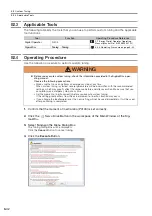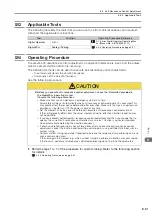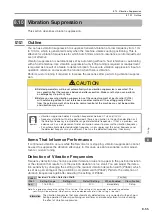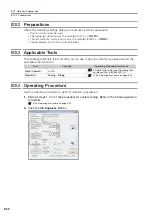
8.9 Anti-Resonance Control Adjustment
8.9.1 Outline
8-50
8.9
Anti-Resonance Control Adjustment
This section describes anti-resonance control.
8.9.1
Outline
Anti-resonance control increases the effectiveness of vibration suppression after custom tun-
ing.
Anti-resonance control is effective for suppression of continuous vibration frequencies from 100
to 1,000 Hz that occur when the control gain is increased. Vibration can be eliminated by set-
ting vibration frequencies through automatic detection or by manually setting them to adjust
the damping gain. Input an operation reference and execute this anti-resonance control adjust-
ment when there is vibration.
Anti-resonance control is automatically set by autotuning without a host reference or autotun-
ing with a host reference. Use anti-resonance control adjustment only if fine-tuning is required
or readjustment is required as a result of a failure to detect vibration.
Perform custom tuning if required to increase the response after performing anti-resonance
control adjustment. If the control gain is increased, e.g., when custom tuning is performed,
vibration may occur again. If that occurs, perform anti-resonance control adjustment again to
fine-tune the parameters.
8.9.2
Preparations
Check the following settings before you execute anti-resonance control adjustment.
•
The tuning-less function must be disabled (Pn170 = n.
0).
•
The test without a motor function must be disabled (Pn00C = n.
0).
•
The control method must not be set to torque control.
•
The parameters must not be write prohibited.
CAUTION
Related parameters will be set automatically when anti-resonance control adjustment is
executed. This may greatly affect the response before and after execution. Make sure that
you can perform an emergency stop at any time.
Before you execute anti-resonance control adjustment, set the correct moment of inertia
ratio (Pn103). If the setting greatly differs from the actual moment of inertia ratio, normal
control of the machine may not be possible, and vibration may occur.
•
Anti-resonance control adjustment detects vibration frequencies between 100 Hz and 1,000
Hz. If the vibration frequency is not within this range, use custom tuning with tuning mode 2
selected to automatically set a notch filter or use vibration suppression.
•
Vibration reduction can be made more effective by increasing the anti-resonance damping gain
(Pn163), but the vibration may become larger if the damping gain is too high. Increase the
damping gain by approximately 0% to 200% in 10% increments while checking the effect on
vibration. If vibration reduction is still insufficient at a gain of 200%, cancel the setting, and
lower the control gain by using a different method, such as custom tuning.
Important






























